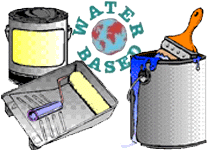Did You Know...
Aerosols no longer contain CFCs that break down the ozone layer
in the upper atmosphere, but they still contain VOCs that pollute
by forming corrosive ozone at ground level in the air we breathe. |
 any
of the products that we use every day add smog-forming air pollutants
to our air. Individually, it may seem like these familiar products add
a tiny amount of pollution to the air, but collectively they spew several
hundred tons of hydrocarbons into the air daily.
any
of the products that we use every day add smog-forming air pollutants
to our air. Individually, it may seem like these familiar products add
a tiny amount of pollution to the air, but collectively they spew several
hundred tons of hydrocarbons into the air daily.
In one year, 35 million Californians using consumer
products emit 82,600 tons of ozone-forming volatile organic compounds
or VOCs into the air. This is equal to 20,000,000 (20 million) new cars
driving 10,000 miles each year. The pollution fallout is so serious
that the Air Resources Board is working with manufacturers to reduce
the hydrocarbon content of some 3,000 products sold in California over
the next few years.
Be sure that every time you, the school
or your family buys, they choose air-friendly products:
1. Buy water-based products or brands that contain low quantities
of volatile organic compounds. Products that contain VOCs are hair sprays,
engine degreasers, anti-perspirants and deodorants, air fresheners,
windshield washer fluids, and household cleaners.
2. Always suggest that people paint with brushes or rollers instead
of a paint sprayer.
3. Use water-based paints that pollute less than oil-based paints and
are easier to clean up.
4. Use safer cleaners like baking soda and/or environmentally friendly
brands in place of harsher products. Go outdoors to use any product
containing harmful chemicals.
5. Keep lids tightly closed on cleaners, workshop and lab chemicals
and solvents, and garden chemicals when not in use, to prevent volatile
chemicals from evaporating into the air.
6. Use pump sprays that emit a fraction of the air polluting compounds
of aerosol cans.
